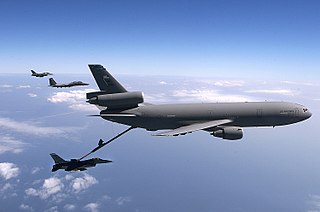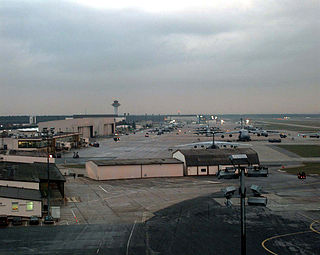
Naval Air Station Joint Reserve Base Willow Grove or NASJRB Willow Grove was a Naval Air Station owned by the U.S. Navy and located in Horsham Township, Montgomery County, Pennsylvania, United States four miles (6 km) northwest of the central business district of Willow Grove, which is north of Philadelphia. The installation was transferred to the Pennsylvania Air National Guard and the name changed to the Horsham Air Guard Station after the U.S. Navy departed in 2011.

The Boeing C-40 Clipper is a military version of the Boeing 737 Next Generation used to transport cargo and passengers. It is used by the United States Navy, Air Force, and Marine Corps. The Navy C-40A variant is named "Clipper", whereas the USAF C-40B/C variants are officially unnamed.

The Boeing T-43 is a modified Boeing 737-200 that was used by the United States Air Force for training navigators, now known as USAF combat systems officers, from 1973 to 2010. Informally referred to as the Gator and "Flying Classroom", nineteen of these aircraft were delivered to the Air Training Command (ATC) at Mather Air Force Base, California during 1973 and 1974. Two additional aircraft were delivered to the Colorado Air National Guard at Buckley Air National Guard Base and Peterson Air Force Base, Colorado, in direct support of cadet air navigation training at the nearby U.S. Air Force Academy. Two T-43s were later converted to CT-43As in the early 1990s and transferred to Air Mobility Command (AMC) and United States Air Forces in Europe (USAFE), respectively, as executive transports. A third aircraft was also transferred to Air Force Materiel Command (AFMC) for use as the "Rat 55" radar test bed aircraft and was redesignated as an NT-43A. The T-43A was retired by the Air Education and Training Command (AETC) in 2010 after 37 years of service.

The McDonnell Douglas KC-10 Extender is an American tanker and cargo aircraft operated by the United States Air Force (USAF). A military version of the three-engine DC-10 airliner, the KC-10 was developed from the Advanced Tanker Cargo Aircraft Program. It incorporates military-specific equipment for its primary roles of aerial refueling and transport. It was developed to supplement the KC-135 Stratotanker following experiences in Southeast Asia and the Middle East. The KC-10 was the second McDonnell Douglas transport aircraft to be selected by the Air Force following the C-9. A total of 60 KC-10s were produced for the USAF. The Royal Netherlands Air Force operated two similar tankers designated KDC-10 that were converted from DC-10s.

The Douglas C-54 Skymaster is a four-engined transport aircraft used by the United States Army Air Forces in World War II and the Korean War. Like the Douglas C-47 Skytrain derived from the DC-3, the C-54 Skymaster was derived from a civilian airliner, the Douglas DC-4. Besides transport of cargo, the C-54 also carried presidents, prime ministers, and military staff. Dozens of variants of the C-54 were employed in a wide variety of non-combat roles such as air-sea rescue, scientific and military research, and missile tracking and recovery. During the Berlin Airlift it hauled coal and food supplies to West Berlin. After the Korean War it continued to be used for military and civilian uses by more than 30 countries. It was one of the first aircraft to carry the President of the United States, the first being President Franklin D. Roosevelt during World War II.

Eighteenth Air Force (Air Forces Transportation) (18 AF) is the only Numbered Air Force (NAF) in Air Mobility Command (AMC) and one of the largest NAFs in the United States Air Force. 18 AF was activated on 28 March 1951, inactivated on 1 January 1958, and re-activated on 1 October 2003. 18 AF is headquartered at Scott Air Force Base, Illinois.

The Douglas C-133 Cargomaster is an American large turboprop cargo aircraft built between 1956 and 1961 by the Douglas Aircraft Company for use with the United States Air Force. The C-133 was the USAF's only production turboprop-powered strategic airlifter, entering service shortly after the Lockheed C-130 Hercules, which is designated a tactical airlifter. It provided airlift services in a wide range of applications, being replaced by the C-5 Galaxy in the early 1970s.

Rhein-Main Air Base was a United States Air Force air base near the city of Frankfurt am Main, Germany. It was a Military Airlift Command (MAC) and United States Air Forces in Europe (USAFE) installation, occupying the south side of Frankfurt Airport. Its military airport codes are discontinued. Established in 1945, Rhein-Main Air Base was the primary airlift and passenger hub for USAFE. It was billed as the "Gateway to Europe". It closed on 30 December 2005.

The Military Air Transport Service (MATS) is an inactive Department of Defense Unified Command. Activated on 1 June 1948, MATS was a consolidation of the United States Navy's Naval Air Transport Service (NATS) and the United States Air Force's Air Transport Command (ATC) into a single joint command. It was inactivated and discontinued on 8 January 1966, superseded by the Air Force's Military Airlift Command (MAC) as a separate strategic airlift command, and it returned shore-based Navy cargo aircraft to Navy control as operational support airlift (OSA) aircraft.

The 932nd Airlift Wing is an Air Force Reserve Command flying unit. It is assigned to the Twenty-Second Air Force, Air Force Reserve Command, stationed at Scott Air Force Base, Illinois.

The 1st Airlift Squadron is part of the 89th Airlift Wing, 89th Operations Group, at Andrews Air Force Base, Maryland. It conducts transport of various high-level U.S. military and government officials.

The 834th Airlift Division is an inactive United States Air Force organization. Its last assignment was with Military Airlift Command, assigned to Twenty-Second Air Force at Hickam Air Force Base, Hawaii, where it was inactivated on 1 April 1992.

Fleet Logistics Support Squadron 30 (VRC-30) was an aviation unit of the United States Navy tasked with carrier onboard delivery. The squadron was nicknamed "Providers" and was based at Naval Air Station North Island, California (USA). In contrast to most other U.S. Navy squadrons, VRC-30 consisted of five separately named detachments, which were assigned to different carrier air wings.

The first predecessor of the squadron was organized in 1940 as the 13th Transport Squadron. During World War II, as the 13th Troop Carrier Squadron, the squadron served in the South West Pacific Theater of World War II, earning two Distinguished Unit Citations, a Navy Unit Commendation and a Philippine Republic Presidential Unit Citation for its wartime actions. Its last assignment was with the 403d Troop Carrier Group at Nichols Field, Luzon, Philippines, where it was inactivated on 15 October 1946.

Fleet Logistics Support Squadron 62 (VR-62), nicknamed the Nomads, is one of five U.S. Navy Reserve squadrons operating the Lockheed C-130T Hercules medium-lift cargo aircraft. Based at Naval Air Station Jacksonville, Florida, the squadron is manned by a combination of traditional part-time drilling Selected Reservists (SELRES) and a full-time active duty Navy Reserve cadre known as Training and Administration of the Reserve (TAR) personnel (previously known as Full Time Support (FTS) personnel from August 2006 to November 2021). The squadron is under the operational control of Commander, Fleet Logistics Support Wing(COMFLELOGSUPWING) at NAS JRB Fort Worth, Texas.

Fleet Logistics Support Squadron 56 (VR-56), nicknamed the Globemasters, is a transport squadron of the United States Navy Reserve providing world-wide airlift using C-40A Clipper aircraft and is based at Naval Air Station Oceana, Virginia. The squadron is under the operational control of Commander, Fleet Logistics Support Wing at Naval Air Station Joint Reserve Base Fort Worth, Texas.

The Air Mobility Command Museum is a military aviation museum located at Dover Air Force Base in Dover, Delaware dedicated to the history of the Air Transport Command, Military Air Transport Service, Military Airlift Command and Air Mobility Command.

Fleet Logistics Support Squadron 54 (VR-54), nicknamed "The Revelers", is a heavy-transport, logistics support squadron of the United States Navy. It is a Navy Unique Fleet Essential Aircraft (NUFEA) squadron based out of NAS/JRB New Orleans, Louisiana and is a sub-command of Commander, Fleet Logistics Support Wing and Commander, Naval Air Reserve Force. VR-54 is a Naval Reserve unit composed of both Training & Administration of the Reserve and Selected Reserve (SELRES) Sailors. The squadron currently flies the Lockheed C-130T Hercules.

Fleet Logistics Support Squadron 55 (VR-55) is a reserve aviation unit of the United States Navy. The squadron was established in April 1976 and is based at Naval Air Station Point Mugu, California. It is equipped with the Lockheed C-130T Hercules.

The 13th Aeromedical Airlift Squadron is an inactive unit of the United States Air Force, last stationed at Travis Air Force Base. The squadron's first predecessor was the 13th Combat Cargo Squadron, which flew men and material in the China Burma India Theater during World War II. That squadron was disbanded in 1948, but was reconstituted in 1985 and consolidated with the unit's second predecessor.
























